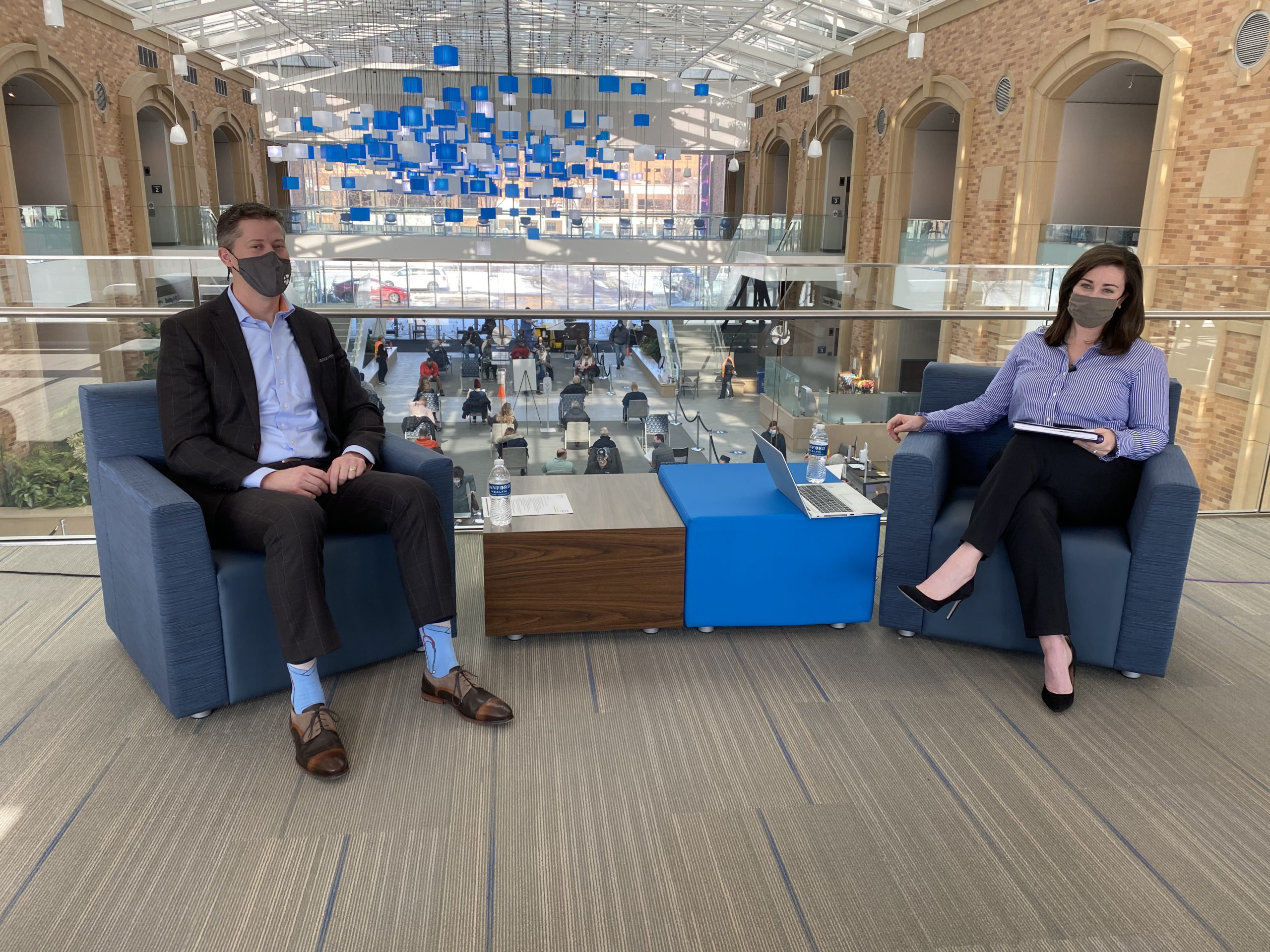The people who know the most about the novel coronavirus are the ones lining up to get the vaccine.
As Sanford Health chief physician Jeremy Cauwels, M.D. emphasizes the vaccine’s safety, he’s impressed as the vaccination rates increase.
He tells Sanford Health News:
- More than 85% of Sanford Health physicians have received their vaccine
- Nearly 80% of Advanced Practice Providers have received their vaccine
- Close to 70% of nurses have received their vaccine
Watch: Dr. Cauwels joins Sanford Health News for a Facebook Live Q&A, Feb. 4
More good news, COVID-19 case numbers are less concerning in the Dakotas currently than other parts of the country.
“Numbers in our hospital are as low as they’ve been since probably July of last year,” Dr. Cauwels said.
He adds, it’s still important to be diligent about wearing a mask in public, maintaining physical distance, washing hands often and staying home when we’re sick — even after getting the vaccine.
Vaccine to seniors, high risk will take time
Currently getting vaccinated at Sanford Health are patients who are at least 65 years old or have two, or more, medical conditions which put them at higher risk for complications.
“In our community, we have 300,000 patients over 65 years old. That’s going to take us a while,” Dr. Cauwels admits.
As each week passes, vaccine distribution improves. Sioux Falls is reaching 1,000 shots in arms per day.
“We will continue to see more vaccine out there, but what it does tell folks like my parents is it’s going to be some time — even at age 74 — before they’re going to get their vaccine. That’s why it’s important to keep up with the things that we’ve been doing: make sure that we’re wearing our masks and protecting ourselves until we can get there.”
Learn more: Sanford helps lead massive distribution effort in SD
If you look at nationwide maps, he said, South Dakota and North Dakota are leading in how many people we’re vaccinating and in how much vaccine we’re using.
“If they send us 1,000 doses, our goal every day is to be out of doses. That’s our job,” he explained. “Next week, we’ll get 12,000 doses in the Sanford system and we hope by the end of the week to be able to use all 12,000.”
He says they can expand that capacity as much as they need to in order to keep giving out doses. For those who can’t reach care as easily, the state is looking into unique ways to reach people with vaccines.
Vaccine brings more freedom in 2021
For a health care worker in a hospital setting, the benefits of these vaccines are clear.
“Thinking about all of the sick people we’ve been around, all of the COVID patients we’ve been around over the last several months, we can feel a little bit more comfortable knowing when you go to work and come home, you have as good a chance medically to not bring COVID home with you and to not get sick from COVID,” Dr. Cauwels said.
The other things, the little things, for everybody are coming.
“I want people to be back seeing their grandkids again. … I want our workers to have breakfast meetings again with breakfast. … I want there to be that interaction that we all crave and that we all enjoy but in order to do that, we have to make sure that we put the skids to the virus and we keep it there.”
Continue your routine care
Patients are going to the clinic but not at volumes Sanford Health leaders would expect.
“We haven’t seen people coming back particularly for things like regular mammograms or colon cancer screenings or some of the things,” he said.
Clinics are ready — and have been ready — to see patients.
“I actually had a conversation with some of our radiologists who read our mammograms, this week, and they are ready to make sure we get the work done and make sure we keep you safe.”
Safe Super Bowl Sunday, everyone wins
Having completed his residency and chief resident year at the University of Kansas, Dr. Cauwels admits he will be rooting for the Kansas City Chiefs.
“That being said, I can also tell you that I’m not going to be rooting for the Chiefs with a bunch of other people. I’m going to be treating this very much like Thanksgiving and Christmas. That is, we’re very pleased with where we’re at right now from a state standpoint, either South Dakota or North Dakota, as far as the amount of COVID we have around.”
He said what we don’t need is a bunch of people getting together in the first two weeks of February and really spreading the virus around again.
“Our recommendations haven’t changed. We still follow with the CDC. We still recommend small gatherings. We still recommend that bubble of people that you’re comfortable hanging out with,” he said.
“We certainly have less concern now than we did in November, but my goal is to prevent a second surge,” Dr. Cauwels said. “My goal is to have everybody in the current priority group vaccinated and then all of the folks in the community vaccinated to avoid a surge and we’re getting there. My only request is that if you’re getting together for the game, get together with the group of people you’ve been hanging out with already and try not to make the gathering that much bigger unless you’re able to social distance a little bit or willing to wear a mask during some of the parties.”
Read more
- COVID-19 vaccine: Separating myths from facts
- Heart and vascular screenings: What’s the difference?
- What to expect before, during, after COVID-19 vaccine
…
Posted In COVID-19, Expert Q&A, Physicians and APPs

